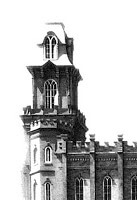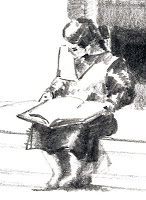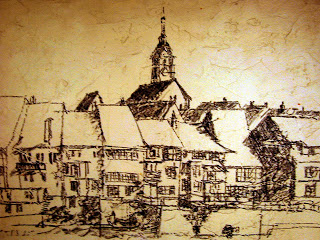How do you look when you hold a pencil?
By Al R. Young
This installment of Studio Windows looks in to the studio windows instead of outward through them, but learning how to see with an artist's eye is still the focus.
In school, where words and numbers were infinitely more important than the making and viewing of artworks, I was taught to hold a pencil in a vise-like grip between the thumb and middle finger; the forefinger being placed on the pencil to steady it. So strict were these requirements that in the hush draped over our first grade classroom the teacher paced up and down between the wooden tables where we strained and bowed our heads above our work, and struck our hands with a wooden ruler if she spied us holding the pencil incorrectly. With our nerves sharpened to a piercing point, we learned to move the pencil about the paper, making symbols that we didn't even know were pictures.
To draw with a pencil, at least the way I do, I not only sharpen it like a scalpel, but hold it as I was taught at school. This is the result:
 |
| Detail from unfinished pencil drawing
of the Manti Temple |
 |
| Detail from a pencil sketch |
The way in which a person holds a tool changes what can be done with it, because it changes the way the mind sees, knowing that it must render within the tool's limitations. Seeing as an artist sees involves groping for visual expression from within the blindness at the end of whatever tool the mind takes up in order to render a visual interpretation of something.
Picking up a brush and thinking pencil-used-to-write or pencil-used-for-math produces a very different result from picking up a brush and thinking something like pencil-used-to-sketch. (I mention pencil because a pencil is not only one of the first implements we pick up as children, but because the intense training associated with it affects the way we pick up such tools ever after.)
My third-grade teacher (who did not strike our hands with a wooden ruler) taught us art, and because she didn't like to discard all the crayon bits we produced, she took the fragments home, melted them, poured the liquefaction into rectangular bar-molds, let them cool, and brought the larger, chubbier, clunkier crayons back to school to be used up. Because of their shape and size, we could not hold them in the "pencil manner."
The lesson? To broaden the way you see, particularly when the tool you use in rendering is too familiar, change the way you hold it. You might even change the surface on which you draw or paint. For example, the following is a charcoal sketch on dry joint-compound, troweled onto a panel to suggest the uneven and rugged surface of the daub part of wattle-and-daub. Drawing in such conditions can help in the discovery of what one's eye and hand are capable of creating -- far beyond the narrow limits of pencil-used-to-write or pencil-used-for-math.
 |
| Untitled charcoal sketch of a cityscape |
Browse articles by year: 2025 . 2024 . 2023 . 2022 . 2021 . 2020 . 2019 . 2018 . 2017 . 2016 . 2015 . 2014 . 2013 . 2012 . 2011 . 2010 . 2009 . 2008 . 2007 . 2006 . 2005 . 2004 . 2003 . 2002 . 2001 . 2000 . 1999 . 1998 . 1997 . 1996
Browse articles by topic: Art lessons . BenHaven Archives . Blank art diaries . Fine art photography . Framing . Illustration . Inspiration and creativity . Isles of Rune . Limited Editions Collection . My Fathers Captivity . News . Novellas . Oil paintings and prints . Operations announcements . Orders and shipping . Overview . Portfolios . The Papers of Seymore Wainscott . Project commentaries . Recipes by Nancy Young . Recommended reading . Recommended viewing . Temple artworks . The Storybook Home Journal . Tips and techniques . Tools supplies and operations
Browse articles by topic: Art lessons . BenHaven Archives . Blank art diaries . Fine art photography . Framing . Illustration . Inspiration and creativity . Isles of Rune . Limited Editions Collection . My Fathers Captivity . News . Novellas . Oil paintings and prints . Operations announcements . Orders and shipping . Overview . Portfolios . The Papers of Seymore Wainscott . Project commentaries . Recipes by Nancy Young . Recommended reading . Recommended viewing . Temple artworks . The Storybook Home Journal . Tips and techniques . Tools supplies and operations